
|
|
5 March, 2002
Although Dr. Jolles has spent time in Little Diomede and is known by many
people in the community, we are here to begin the first phase of a new study
and this is the first time she has been here during the winter season.
Subsistence activities and the variety of foods that are available vary with
the seasons, and this is an excellent opportunity to develop a greater
understanding of which foods are plentiful at this time of the year. Usually
winter weather conditions are extremely wet and cold, sometimes reaching to
sixty degrees below zero with the wind-chill. So far, weather conditions
have been unusually mild with clear sunny days ranging from 0 to 10 degrees
Fahrenheit and warmer winds from the South or east. The notebooks containing
transcripts of previous interviews with elders from the community have been
distributed to every household on the island, and Dr. Jolles and I have begun
the process of daily interviews. We have learned that some of the elders
who went to Nome for the Elder's Council have remained there, and several
people have gone to the mainland for medical care. And, because school is
currently in session we are beginning with adults who have expressed an
interest in taking part in the study. As the study progresses over the next
three years, Dr. Jolles hopes to interview and include the experiences of
several generations, including both male and female elders, middle aged
adults and young people over the age of 14--as required by federal child
welfare laws.
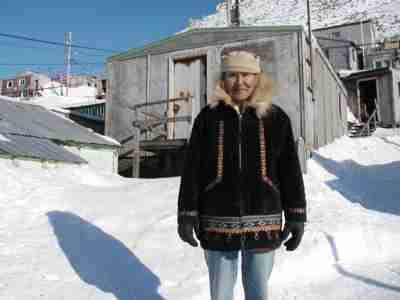
We have been very fortunate to spend several sessions interviewing Arthur Ahkinga. He is in his mid 50's, and while not yet considered to be an elder, he is a fluent Inupiaq speaker with a great deal of knowledge and personal experiences that relate to subsistence and traditional food getting activities. With Arthur's permission, all interviews are taped and recorded. His images, words and the diagrams and maps that he is helping to develop will be returned to the community in future notebooks as part of this community's rich and very unique history.
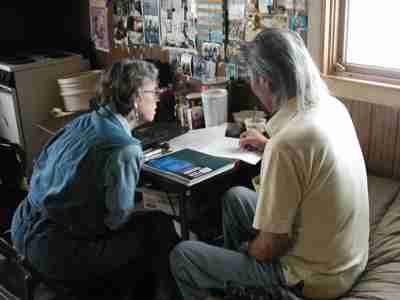
Although Carol and I need to be up and out of the library/teacher's work room where we are sleeping by 7:30 am, most interviews take place throughout the afternoon and late into the evening. The work days are long and intense but extremely pleasant. Houses are small, sometimes just one main room with additional sleeping space so interviews and social visits are very much effected by family needs and weather/hunting opportunities. Electricity has been available on the island since the mid 1970s and most homes not only have an electric stove, but also a refrigerator. That said, life in this remote arctic region very much revolves around weather conditions and the availability of food. When the weather is clear and good, and marine mammals such as seal are plentiful, subsistence needs take precedence. Here, we are guests in Arthur Ahkinga's home where he and Carol are working to add information to a food chart that she has begun to develop. They are documenting the seasonal availability of different foods that form the basis of a traditional Eskimo diet. Arthur is also documenting the Inupiaq name for each of the foods, such as different kind of birds and their eggs, and the marine mammals upon which survival has depended for generations.
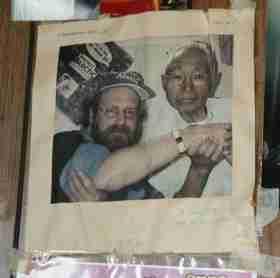
Dr. Jolles is very interested in looking at the changes and transmission of traditional knowledge over the last century and from one generation to the next. For that reason, it is very important from a social science perspective to document the experiences of different generations within a single family. This is a photograph of Arthur's father, Oscar Ahkinga. Oscar was a respected elder in the community with a great deal of knowledge about hunting and gathering as well as experience as a carver. Sadly, Oscar passed away a few months ago, however, Carol had the opportunity to interview him several times and has documented many of his stories in the notebook that she compiled. He was a very accomplished carver whose skill in creating bracelets from walrus tusks and polished baleen helped support his family. Federal law protects whales and other marine mammals from poaching or sport hunting. However, native people's needs and rights to maintain their subsistence diet has meant that strict limits and rules dictate how many animals may be taken. Only the aboriginal peoples of Alaska may possess the tusks and ivory from walrus. The carving of teeth, tusks and vertebrae, dance, drumming and traditional methods of using skins for boats or as items of protective clothing are important elements of cultural knowledge that are a vital aspect of subsistence.
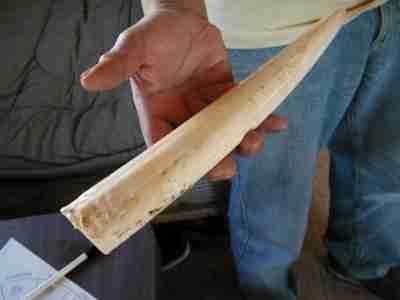
Adult males, called bulls, have large thick tusks that they also use as a form of self-protection. Females or cows and their calves also have tusks. In fact, all walruses have tusks which they use as ice picks to pull themselves up onto ice floes, as well as tools uncover the clams and crabs that they feed on from the bottom of the sea. Walruses are mammals, just like human beings. That means that just like us, they have hair or fur on their bodies, they are warm-blooded, their young are born alive and nurse (or drink milk) from their mother's bodies. And, just like humans and other mammals, they must breathe oxygen with their lungs. Although walrus are marine mammals who spend at least 80% of their lives in the sea, they must breathe air to survive and can actually drown. I've learned that tusks play another important role: when the sea ice has melted and only very small pieces of ice are left, walrus can use their tusks to keep their noses above water while they sleep. Then, if a predator approaches, they can quickly disappear into the water and escape!
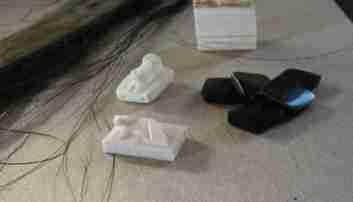
Knowing that I am greatly interested in art and am going to be sharing a great deal of my experiences from Little Diomede with students, teachers and other community members at home, Arthur has been kind enough to share a collection of items that were his fathers. Here is a strip of dried baleen, a small section of tusk that Arthur's father was in the process of carving, two carved ivory links for a bracelet, and several small polished sections of baleen that would have been used as spacer beads in a traditional bracelet. There are two kinds of whales; those with teeth (such as orcas) and those who use a huge brush-like filter called baleen. Baleen whales are among the largest whales in the sea, but they feed on some of the tiniest animals in the sea, called krill. Inorder to meet their enormous nutritional needs, they must eat huge amounts of krill. To do this they swallow huge mouthfuls of water...hundreds and hundreds of gallons of sea water at one time, enough to partially fill a swimming pool, and then push the water out through their baleen: expelling the ocean water while keeping the tiny krill to ingest. In earlier times, baleen was used to make fishing lines, tools and other utilitarian objects. Now, it is often used to weave fantastic baskets or in art objects such as carvings.
Contact the TEA in the field at
.
If you cannot connect through your browser, copy the
TEA's e-mail address in the "To:" line of
your favorite e-mail package.
|
